The Wuthering Moors archive consists of scores of blogs about one controversial grouse moor in West Yorkshire, Walshaw Moor, which sites above Hebden Bridge.
My first blog on this subject was on 19 March 2012 and I am sure that this series of blogs will get into the 90s at least before it ends.
The most recent blogs are collated here and I will add other already-published blogs to this long list as time allows.
WUTHERING MOORS 83

The Walshaw Moor Estate has withdrawn its clearly flawed planning proposal for a new track across Walshaw Moor. This brings to an end the latest chapter of this long-running story in which this blog has played its part.
And this article in the local Burnley Express shows moorland monitors visiting Walshaw Moor.
WUTHERING MOORS 82
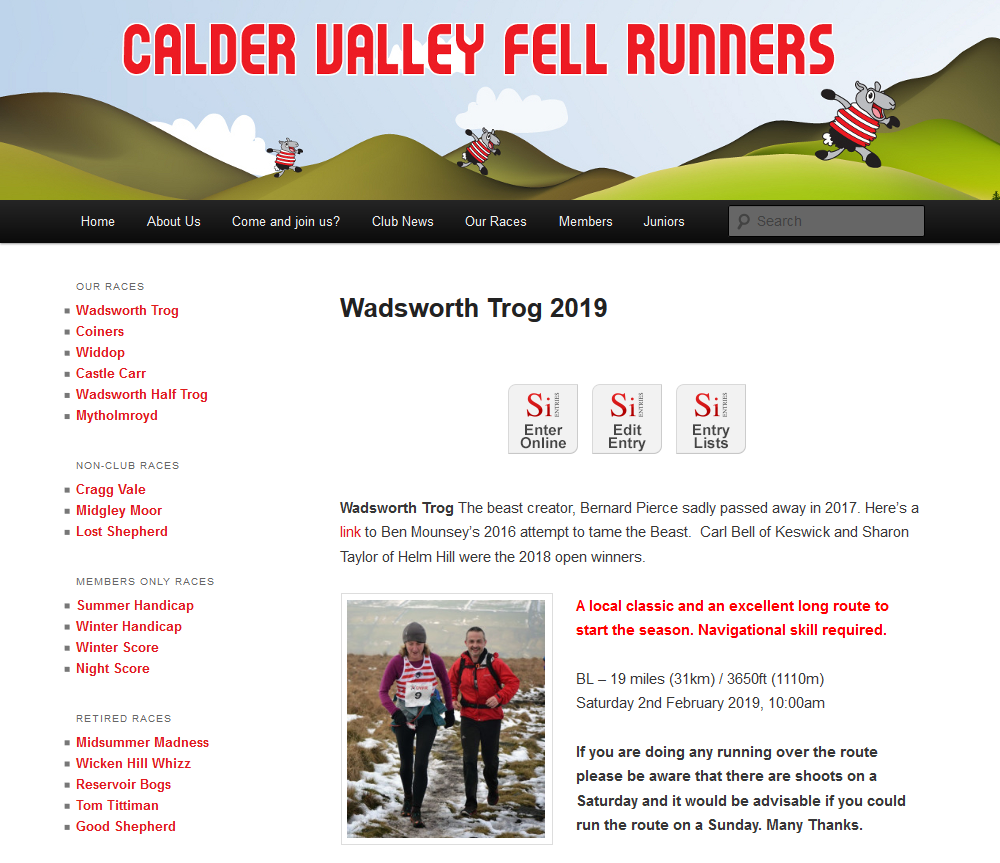
Tomorrow, Saturday, there is a fell run over parts of Walshaw Moor organised by the Calder Valley Fell Runners and called the Wadsworth Trog. We’ve missed the chance of entering (damn!) this race of 19 miles and a height range of over 3600′.
Few of the entrants will probably realise that Walshaw Moor is one of the most controversial pieces of moorland in the country – the scene of legal action by Natural England in the distant past, the RSPB and myself.
Whereas in 2012 Natural England took legal action against the land owner, Richard Bannister, over his alleged unauthorised building of tracks and structures on this designated moorland, this week we heard that my legal challenge of Natural England’s agreement of a plan which included more track building, has forced Natural England to oppose the development and write to Calderdale and Pendle Councils accordingly.
Natural England which once stood up for wildlife against damaging development has now had to be forced by legal action by a private individual (that’s me!) to do their job properly – the job we taxpayers are paying them to do.
The runners won’t see much wildlife at this time of year and they’ll have their heads down anyway. Good luck to them all! But they are running over a battleground – a battle ground to ensure that wildlife laws are enforced and respected.
WUTHERING MOORS 81
This blog looks in a bit more detail at the volte face that Natural England has been forced to make as a result of my (our) legal challenge. A bit later today I will take a broader view of what Natural England needs to do to regain some credibility and public confidence.
Although the letters sent by Natural England to Calderdale and Pendle Council planning authorities cite a load of legal guff and ‘a broader evidence base’ for their about-turn on whether the proposed track across protected blanket bog was fine and dandy or damaging to a protected habitat the facts of the matter are that Natural England has opposed this track before, correctly, on the existing evidence and legal casework, and failed to do its duty this time last year. Natural England and Defra are gagging to get the European Commission off their backs over failure to implement EU-wide environmental legislation properly in respect of blanket bogs and were willing to give landowners what they wanted (and landowner Richard Bannister wants this track) in order to sign useless agreements that pretend to protect blanket bogs but in fact do not (see here, here and here for background).
There are serious questions to be asked about this case (and I will come back to the general issues later today).
Natural England was forced to review the information on peat depth along the track by the brilliant work of Bob Berzins who went out with a GPS and a metal rule and measured them. Bob – you are a star!
When Natural England measured the peat depths along the track it found that 70% of those measurements were of 40cm or greater depth whereas the information in the agreement that Natural England had signed stated that only 26% were of such depth. How did this happen? How common are such errors? What steps will Natural England take to make sure that it checks all the information on which such agreements with land owners are made in future? Why has it taken so long for Natural England to admit its negligence?
Back in early November I blogged about the fact that the Walshaw Moor Estate had applied for planning permission to build a track across its land. Why has it taken three months for Natural England to react to this? When were the new measurements of peat depth made? And in any case, having admitted its errors back in May, did Natural England liaise with Walshaw Moor Estate and make it clear that their proposal for a track would be opposed by Natural England? Did Pendle and Calderdale planning departments ask Natural England for their HRA and why has it taken so long to produce it?
I’d be a bit surprised if Richard Bannister gives up on his desire for a new track cutting through this protected habitat. I’d like to think that if we have to fight this battle all over again, and I wouldn’t rule it out, then Natural England will do its job properly. But if it doesn’t, then I’ll be coming back to you all and asking for your help in continuing the fight for our moorland to be protected from damage and our wildlife to be treasured and protected.
By the way, if we have a no-deal Brexit then this will be almost infinitely more difficult. If we have any sort of Brexit then it will be more difficult. If we Remain then it is difficult enough – not because of the EU but because Defra and Natural England aren’t doing their jobs properly.
The progress we have made in forcing Natural England to do its job, would not have been possible without a whole bunch of people. Thank you to Bob Berzins – an exceptional man. Thank you to our legal team at Leigh Day (especially Carol, Lewis, Tessa (now on maternity leave) and Tom (now joining the team), and thank you to those of you who supported the crowdfunder that has enabled this progress to be made.
WUTHERING MOORS 80
Back in May we won a significant victory against Natural England’s decision to sign an agreement with the Walshaw Moor Estate which included a new track across the protected landscape of the moor.
You may think that was the end of it but no, we’ve been nagging away at NE for the last few months over a new Habitats Regulations Assessment.
Yesterday my lawyers heard from NE that NE has completed a new HRA and on the basis of that assessment they have written to Calderdale and Pendle local planning authorities objecting to the proposal to build a track across Walshaw Moor.
That is what NE should have done right from the start but our legal challenge made them do it. It might never have happened without us – so take a bow everyone who has supported this case.
In particular, take a bow Bob Berzins who measured the peat depth along the proposed track and showed that it was significantly deeper than the planning proposal had admitted. That information certainly helped (see below).
I don’t want to take anything away from Bob’s work but the result might well have been the same without that new information because the case against the track was very strong anyway – that’s why NE have objected to it in the past and that’s what made their supine acquiescence all the more craven this time around.
So, not only did we win and make NE re-do their work, but when they did it properly the result came out, as it always should have done, completely differently, the exact opposite, from their first attempt. The environment, blanket bogs and moorland wildlife are now safer than they would have been without our challenge.
I’m elated. Thank you to our brilliant legal team and thank you for all those who helped to make this happen.
I’ll come back to this later but at the moment I am smiling from ear to ear.
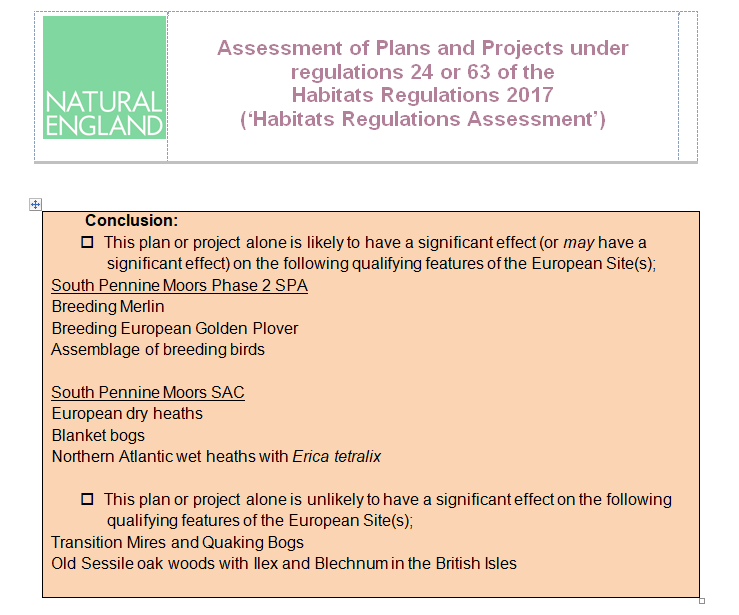


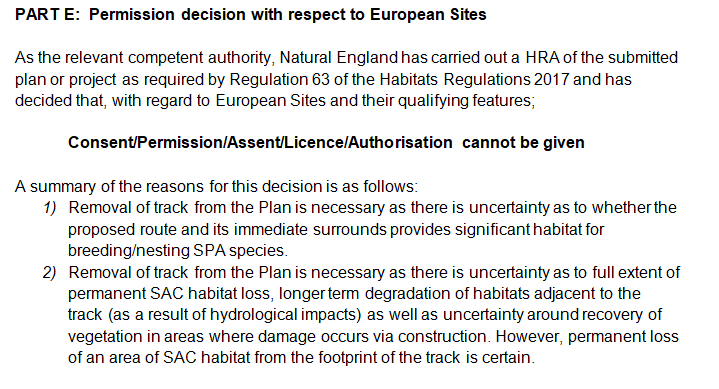
WUTHERING MOORS 79 – are these some new grouse butts?
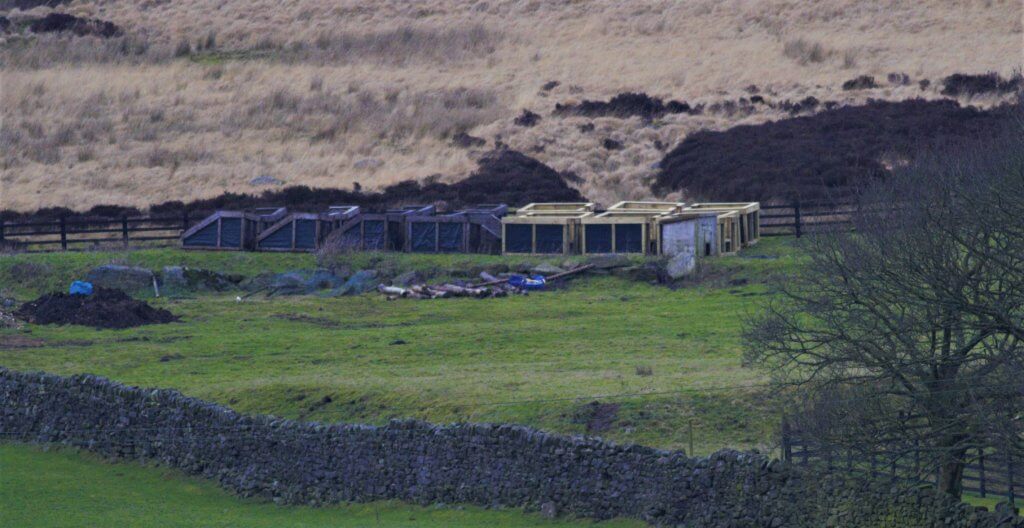
Photo: taken on 31 December 2018
I hear that there is a lot of activity on Walshaw Moor these days – and also these nights. Locals have heard that there are some more grouse butts going in to the moor. No doubt Natural England would be aware and would have consented this activity if it is to occur on the SPA/SAC?
This is what they can look like when in situ …
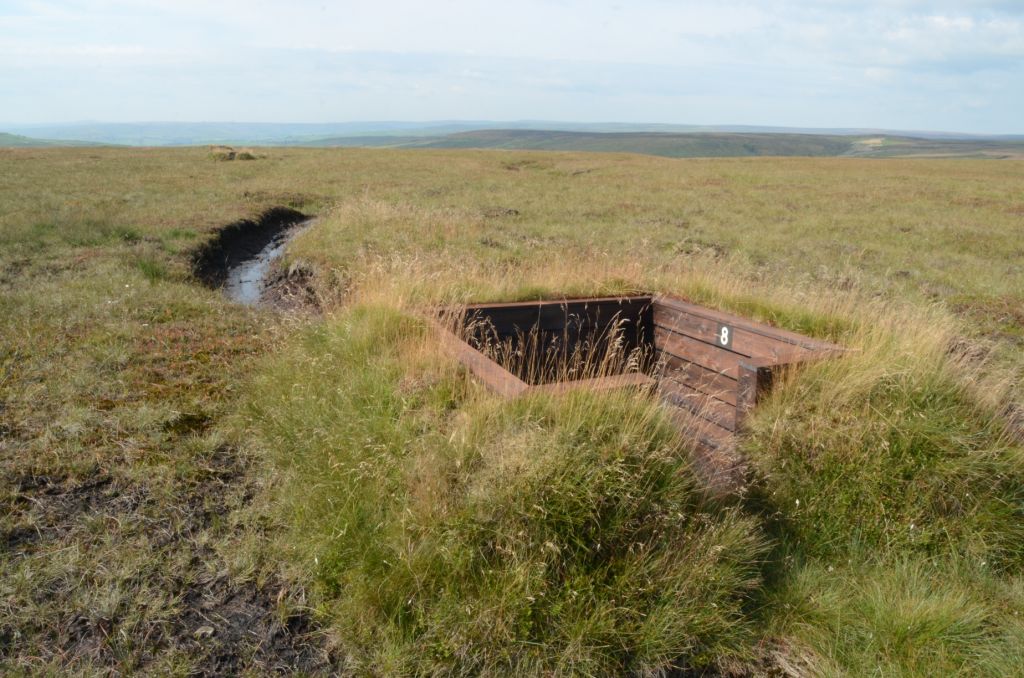
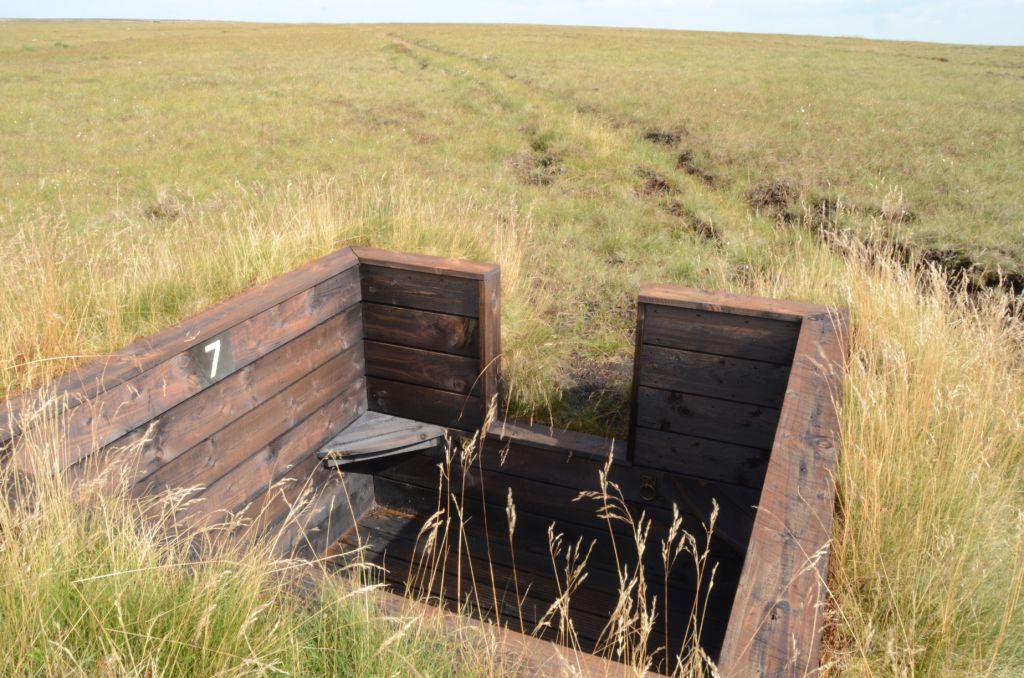
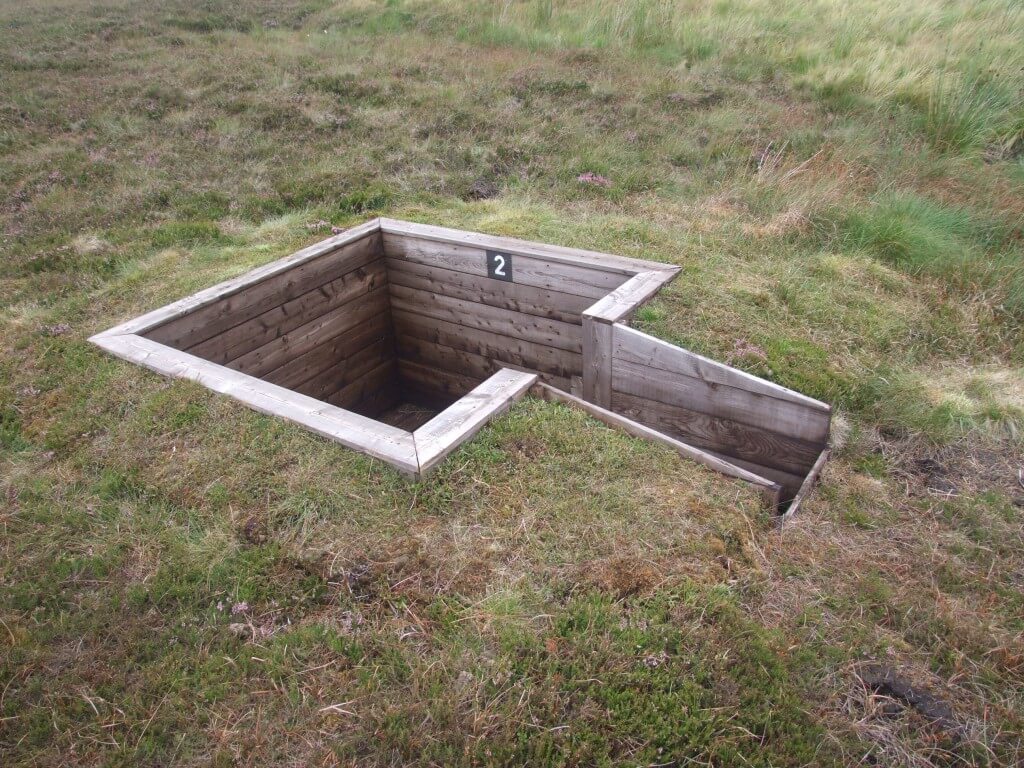
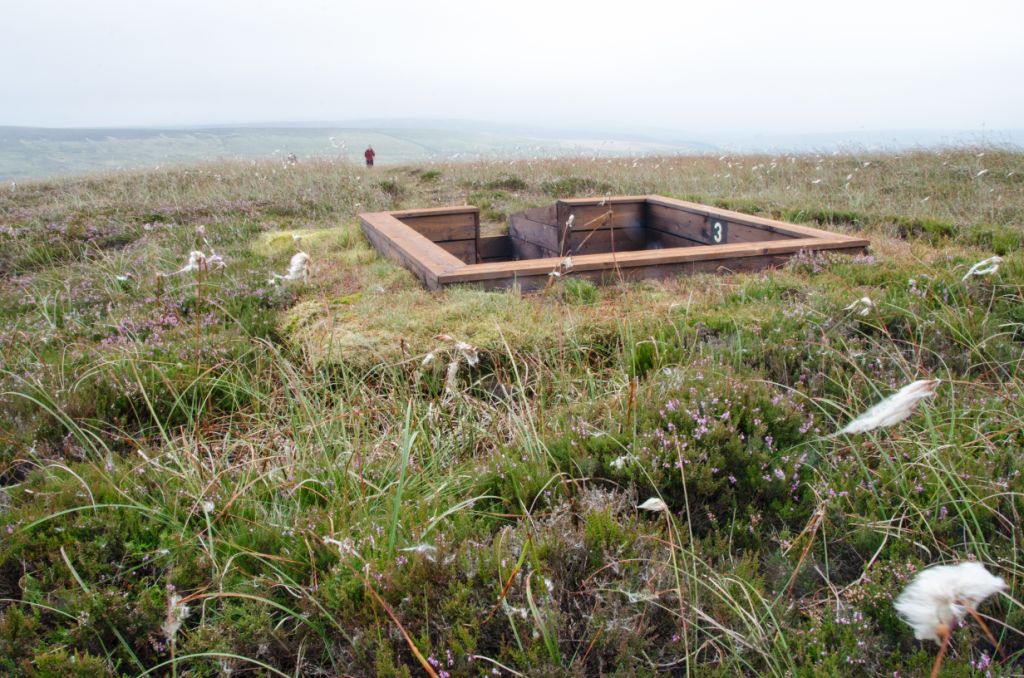
WUTHERING MOORS 78 – NE and Defra must act
This post is about damaging tracks, past and present, on protected moorland.
I’d like to take you back in time on Walshaw Moor.
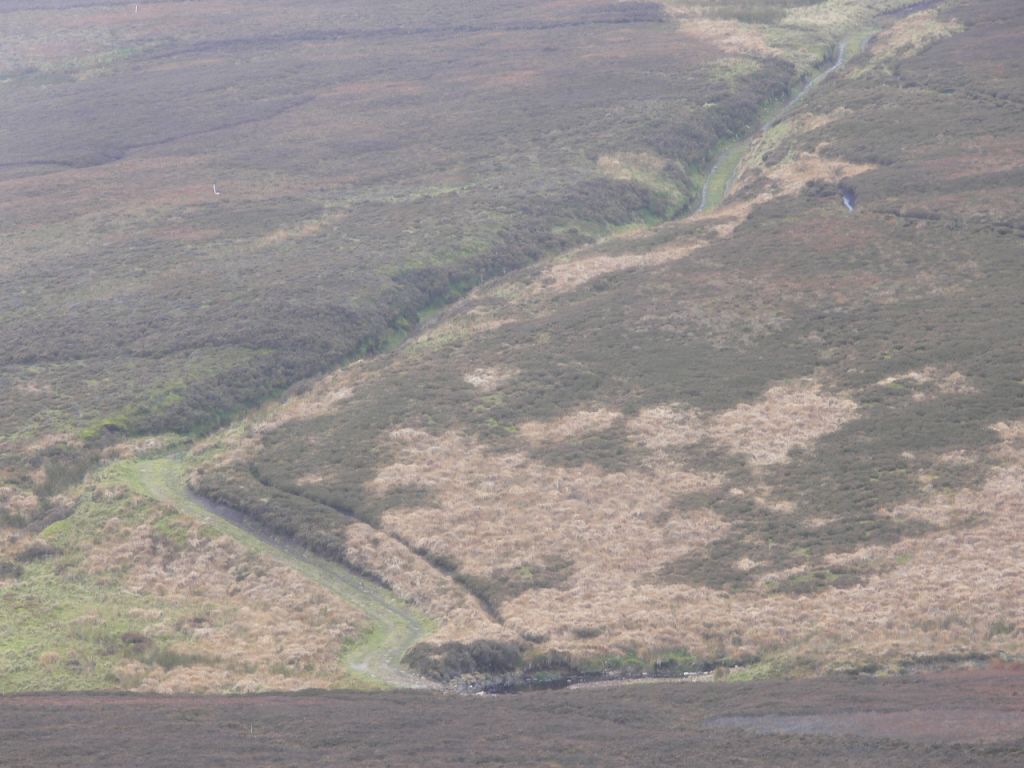
This photograph was posted on this blog in Wuthering Moors 39, 13 September 2013.
I pointed out that this place was marked on the OS map as a stream but now (in 2013) it seems to be a track.
I can point this area out to you on the Walshaw Moor Catchment Restoration Plan map here…
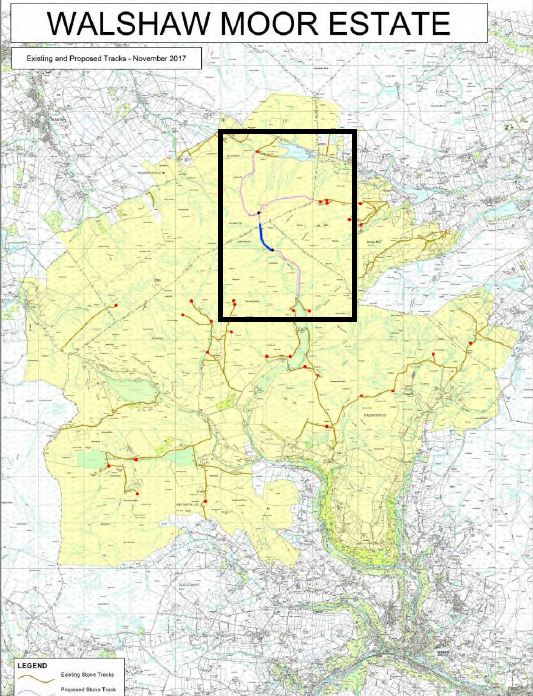
We are looking at the area to the bottom left of the left hand corner of the black box on the map above. This bit…
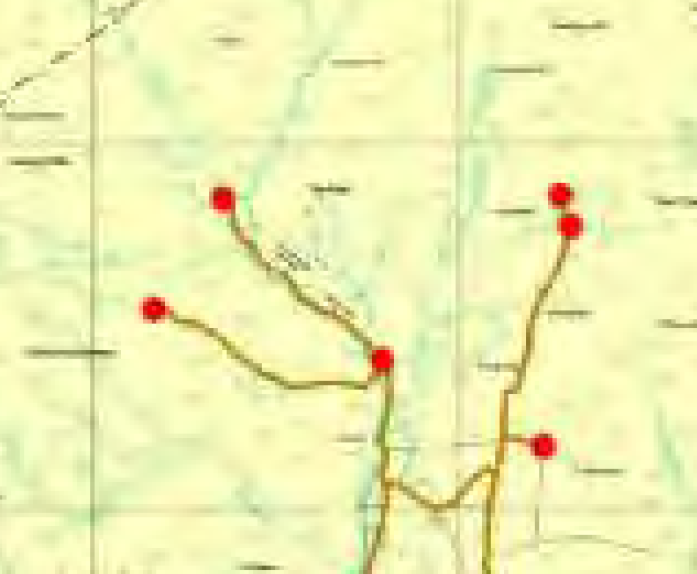
Yes, all a bit fuzzy but we can do better than that. Here is the most recent satellite image from Google Earth (June 2018)…
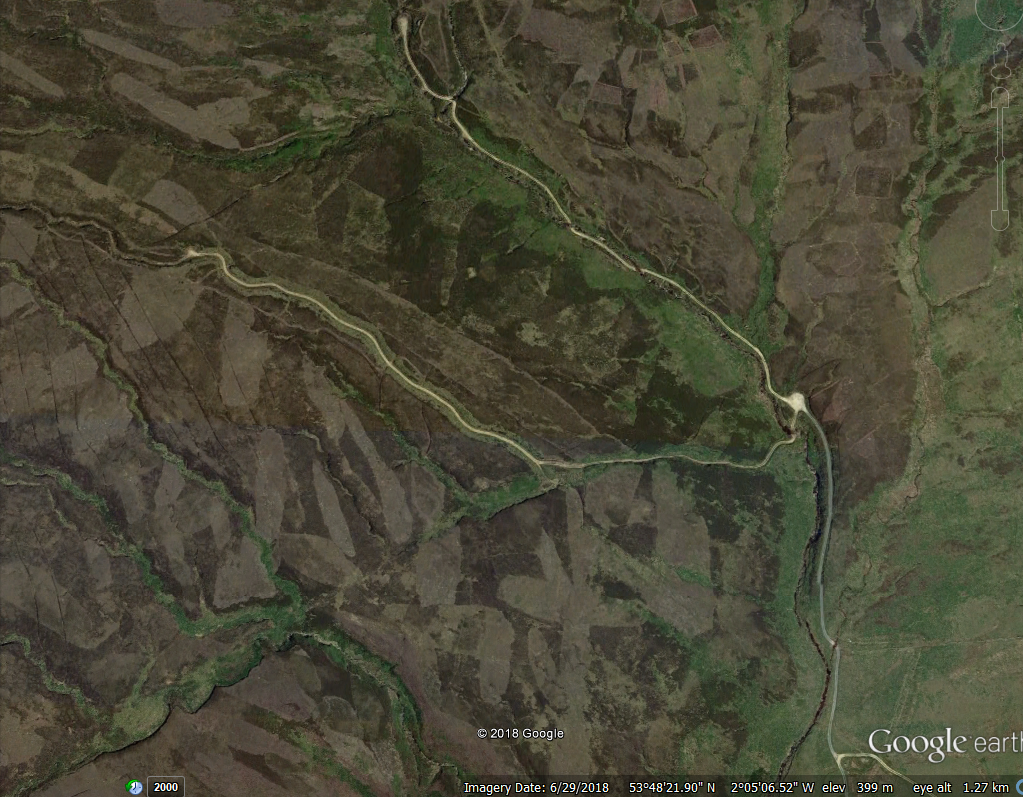
Yep, there are the two tracks and the lower one, the left hand arm of the wonky Y shape, is the one in the photograph.
Here is the same place in 2006 (also from Google Earth)…
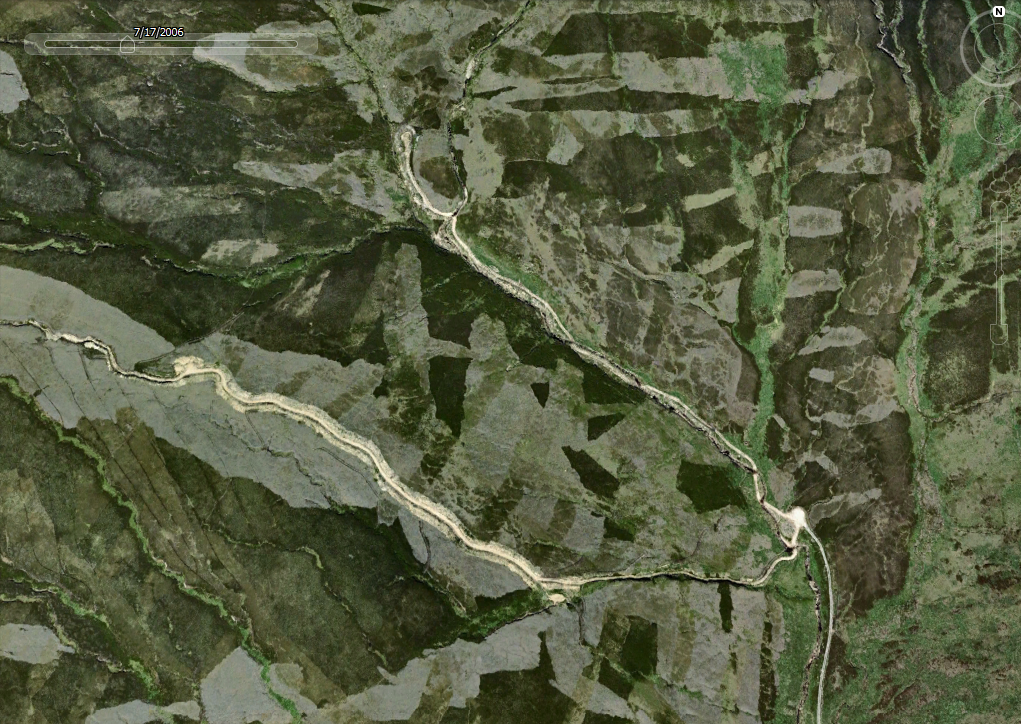
Same tracks in the same place.
But lo! through the wonders of satellite imagery we can have a look at the same area in 2003 (also from Google Earth)…
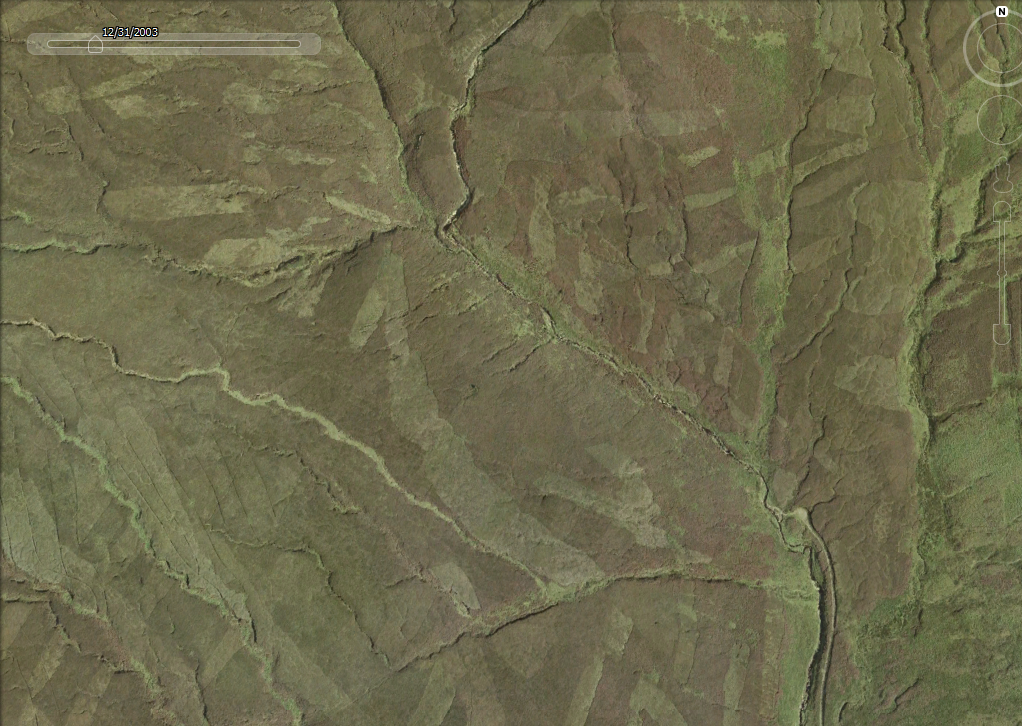
No tracks this time – just a stream, or sike, or syke.
It’s very obvious that someone built some tracks here. Here is the relevant area from the JNCC MAGIC system. You can see the tracks on the OS map.
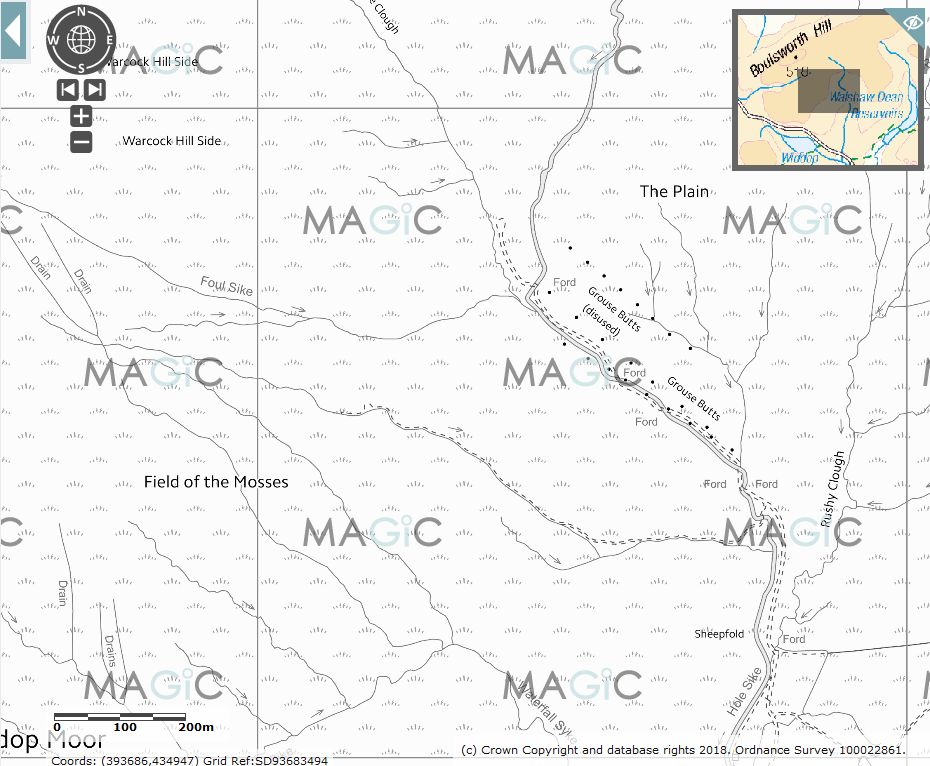
I’d like you to glance at the top left hand area of this map (a part of the Walshaw Moor estate with which you should now be becoming a bit familiar). See the name Warcock Hill? I wonder what a Warcock is?
This seems to be the area where the estate plans to ‘mitigate’ the impacts of the new track, the completely new track which hasn’t been built yet (and I hope never will be) by restoring the blanket bog. Basically the estate is saying that the damage done by building a new track (the one highlighted in the black box on the map higher up this post) will be offset by doing some habitat improvement down in this part of the estate. See here from the planning application papers…

Well that’s interesting. This part of the SSSI (Unit 51) is in Unfavourable No Change condition – I can show you that on MAGIC because it’s an alarming orange colour…
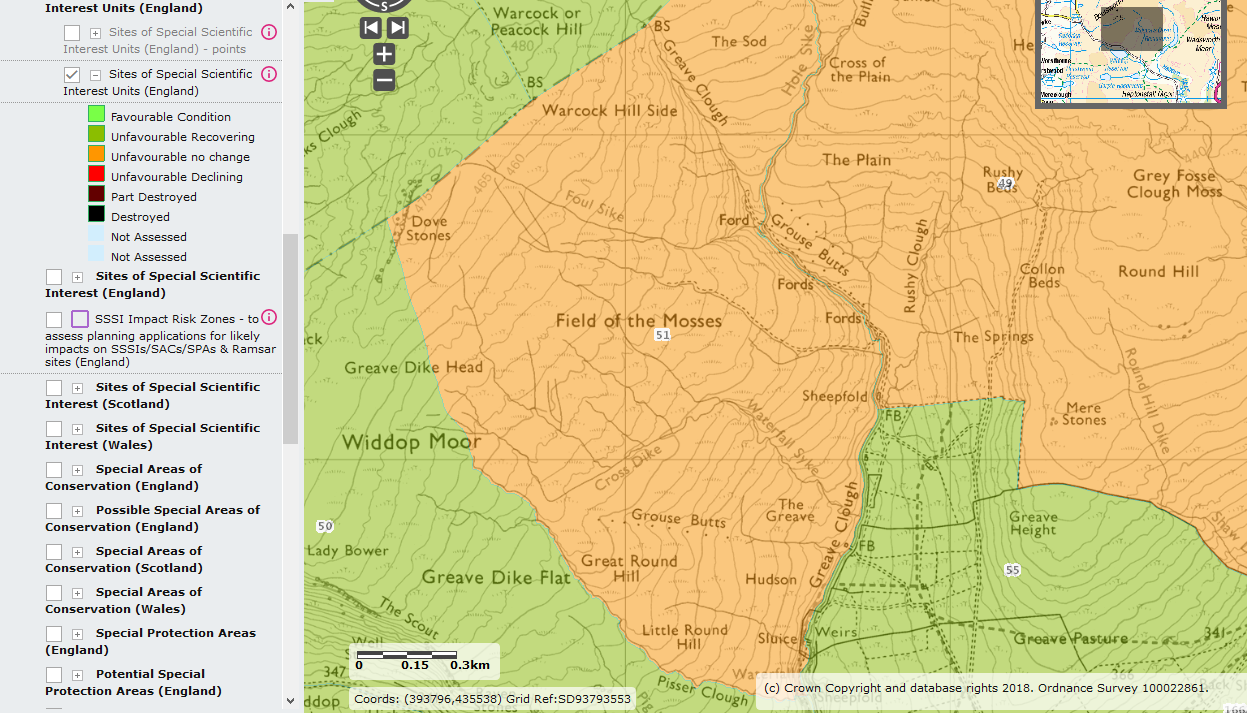
So my understanding is that’s not legal. You cannot use restoration of the habitat in one damaged part of an SSSI/SPA/SAC as mitigation for damaging another part of the SSSI/SPA/SAC. You can see why that isn’t allowed – it’s just moving the damage around rather than repairing it. You’d have to be taking the mickey to suggest such a thing.
If we have a look at SSSI Unit 51 we find that an NE staff member, Andrew Clark, rather pithily commented that for Unit 51:
Restoration works are required to ameliorate the loss and damage to habitat as a result of unconsented operations. Enforcement action is being undertaken to address this issue.
That damage is going to include building tracks, turning circles, grouse butts and drainage etc etc. the enforcement action mentioned is presumably the court case that NE took and which collapsed in 2012. It is difficult to know how much of the issue was addressed.
So, many years ago this grouse shooting estate carried out unconsented actions and it is not clear how much of the habitat damage has been dealt with. Some of those damaging actions were certainly carried out in Unit 51. The estate has been paid large amounts of public money in order to repair some of the damage but NE and Defra have admitted that not all of the damage will be repaired under their agreement with the estate. Now the estate wants to build another track which will cause some more damage. NE consented that track through a Habitats Regulations Assessment which my (our) legal action showed to be unlawful back in May this year.
The estate has now re-applied for planning permission and come up with a plan for mitigation of the damage of the new proposed track which involves carrying out works on a part of its land which was damaged in the past by unconsented operations, and which is in Unfavourable condition, and which the estate has an obligation to get back into Favourable condition (new track or no new track), and which NE has a duty to enforce.
NE must simply object to this planning application and/or tell the two planning authorities involved that they cannot consent the track. And Defra must ensure that this happens.
Or we must.
WUTHERING MOORS 77 – a track going nowhere
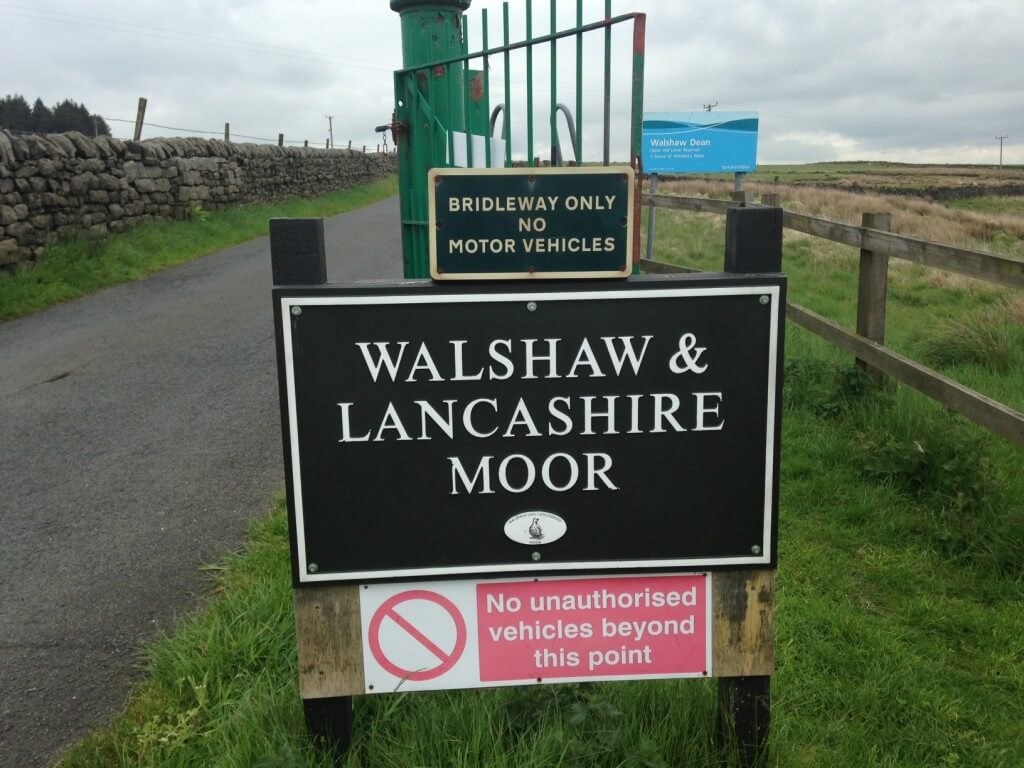
Introduction: This post is about a track that a grouse shooting estate wants to build across their grouse moor. The land is designated because of its nature conservation importance. I, with the help of some very clever lawyers and the financial support of many of you, have stopped this track being built once on the grounds that the Habitats Regulations Assessment carried out by a government agency Natural England, and authorising it, was unlawful.
The track is a track, but this track is mixed up with grouse moor burning, potential infraction proceedings against the UK government, floods in the Calder Valley, and the future of driven grouse shooting.
Blog posts on this site entitled Wuthering Moors are about the issue of burning of blanket bogs by grouse shooting estates (e.g. Wuthering Moors 28, 15 October 2012), the inability of the government agency Natural England to do its job properly on regulating landowners on protected moorland sites (Wuthering Moors 68 – the background to an unlawful decision, 11 May 2018 and Wuthering Moors 67 – a significant victory, 10 May 2018) , and the pickle into which the UK government has got itself with the European Commission over its poor implementation of the Habitats Directive (eg Wuthering Moors 70 – EU infraction proceedings, 13 August 2018).
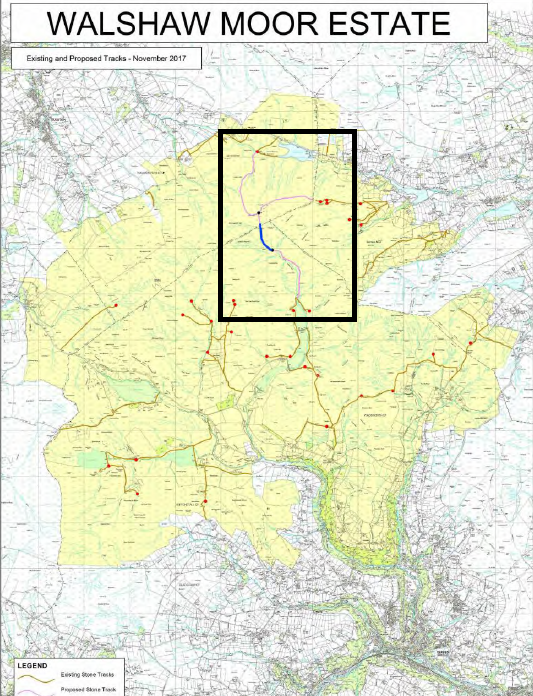
Thank you to everyone, quite a few of you, who have pointed out to me that the Walshaw Moor Estate has renewed its planning application to build a track across blanket bog in the hills above the Calder Valley. It is planning application 18/00237/FUL and can be found here.
Walshaw Moor Estate appear to have put in for planning permission for a track – again! For anyone to grant planning permission for that track there would have to be a proper Habitats Regulations Assessment of the track. Back in May, thanks to our legal challenge, NE were forced to review their HRA because it was unlawful.
Our lawyers at Leigh Day have kept in touch with NE over the intervening period and are contacting them again now. To the best of our knowledge there is no existing proper HRA that consents this proposed track.
We’re on it – watch this space!
WUTHERING MOORS 76

Michael Gove has asked moorland owners to be good boys (and girls – although all the landowners in the room at the time were actually men) and to stop damaging blanket bogs through burning them. Burning is carried out so that men (and a few women) can shoot lots of Red Grouse for fun as it creates the perfect habitat for this gamebird (well, until they are shot, of course).
Many grouse shooting estates signed up to a voluntary agreement in order to help the Secretary of State for the Environment to re-assure the European Commission that he was getting a grip on the situation, and that the Commission should hold back from infraction proceedings against Defra for failing to implement the Habitats Directive.
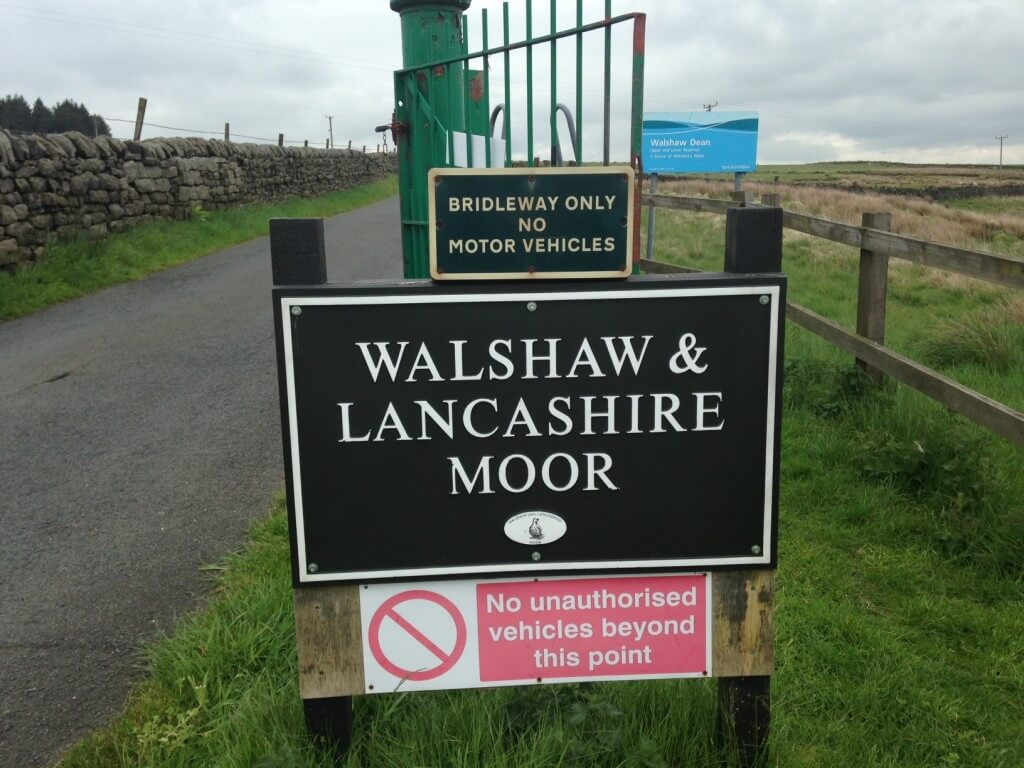
Ironically the estate whose behaviour kicked off a failed legal case from Natural England in 2011, which itself triggered complaints from local residents and the RSPB to the European Commission, and which has led to Defra wanting to be seen to do something on this subject is the Walshaw Moor Estate in West Yorkshire.
Walshaw Moor had not, and as far as I know has not, signed up to the rather worthless voluntary agreements that other estates have signed.
So it comes as no surprise that burning of blanket bog habitat continues this burning season on the hills above Hebden Bridge.
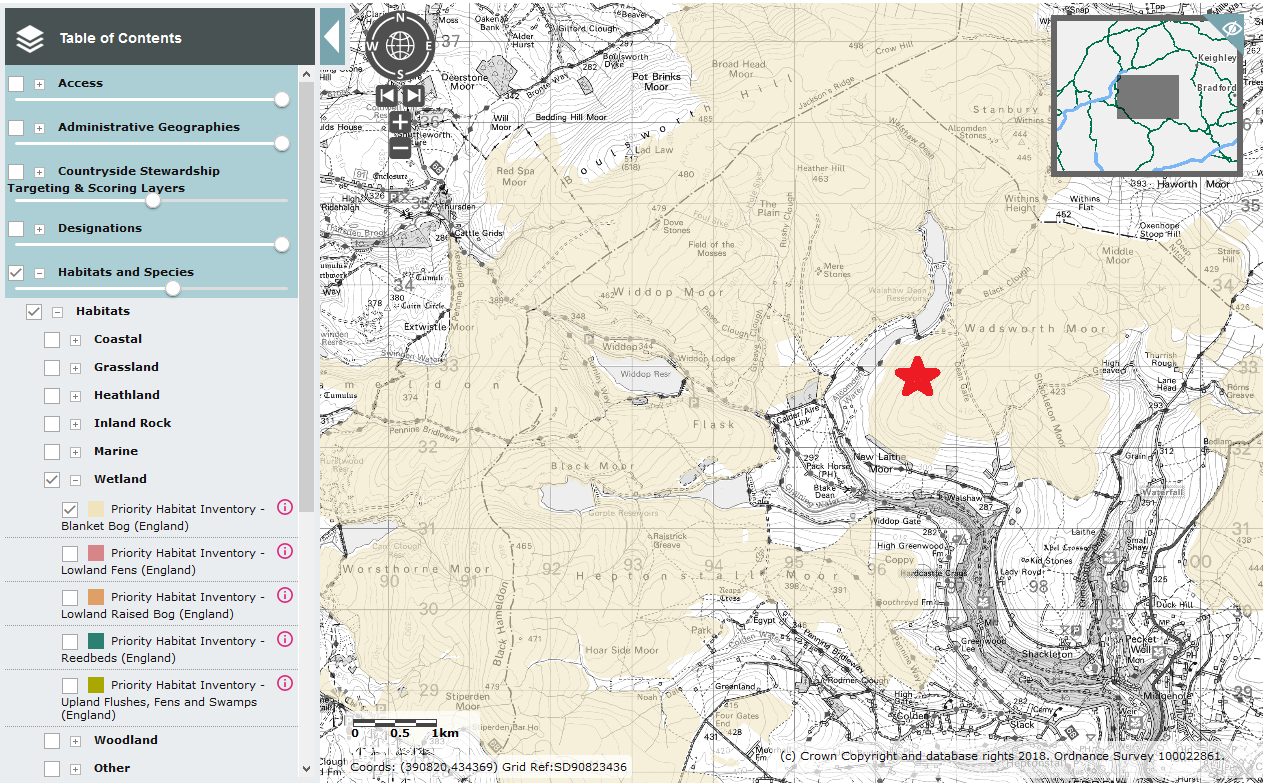
Screenshot from Defra MAGIC system showing area of blanket bog (buff shading) and the area being burned on Monday (red star) pictured above and below.
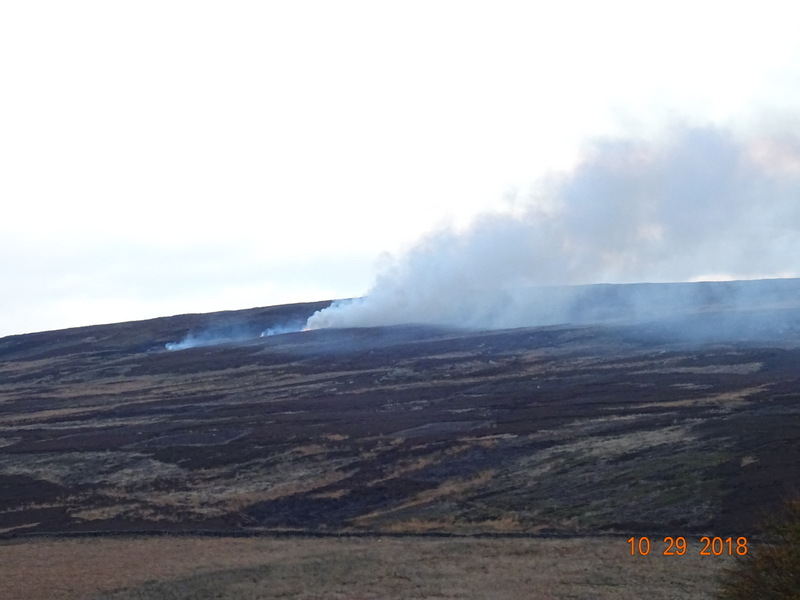
It is to be hoped that the European Commission isn’t so foolish as to believe that Defra is addressing this issue properly.
There are three levels of inadequacy in the Defra approach:
- not all estates have signed the voluntary agreement – Walshaw Moor has not signed it – and so damaging burning continues (as documented in these images)
- there is evidence that even some estates who have signed up to the voluntary agreement are not sticking to it – Natural England should be checking these and reporting back to Defra (and the European Commission should be aware that a list of estates owners from Defra does not necessarily reflect what is happening on the ground)
- the formal agreements which NE is seeking to agree with individual estates to replace the voluntary agreements are riddled with loopholes which will allow damaging burning to continue (eg the one for Walshaw Moor here, and see here too)
Apart from being useless, Defra’s approach is perfect.
Defra appears to be completely in thrall to grouse moor interests. Not only does Defra not get a grip of habitat damage to protected wildlife sites by this small group of game-shooters but nor do they get a grip on wildlife crime against protected wildlife species by this same small group of shooting interests (see blog at 6pm this evening).
WUTHERING MOORS 70
The Guardian has an excellent story on burning of blanket bogs on grouse moors today. Well done to Guy Shrubsole who has done a better job than I managed in getting these details out of Defra.
The papers released by Defra confirm what you will have heard in this blog: that Defra is under the cosh because the European Commission is pursuing infraction proceedings against the UK for non-compliance with the Habitats Directive in regard to protection of blanket bogs. The RSPB complaint which was taken in October 2012 (see Wuthering Moors 28, October 2012) is playing out as Defra attempts to persuade the Commission that it has everything under control (see Wuthering Moors 68).
But it is my view (see Wuthering Moors 58, Wuthering Moors 68) that Defra and NE are trying to pull the wool over the eyes of the European Commission by getting land owners to agree a form of words that looks as though it rules out damaging burning of blanket bogs but in fact does nothing of the sort. It was one of these agreements, for Walshaw Moor Estate, that I successfully challenged earlier this year (Wuthering Moors 67) and where NE had to admit that the agreement they had signed was unlawful.
Here are the minutes of a Roundtable meeting of 1 February this year.
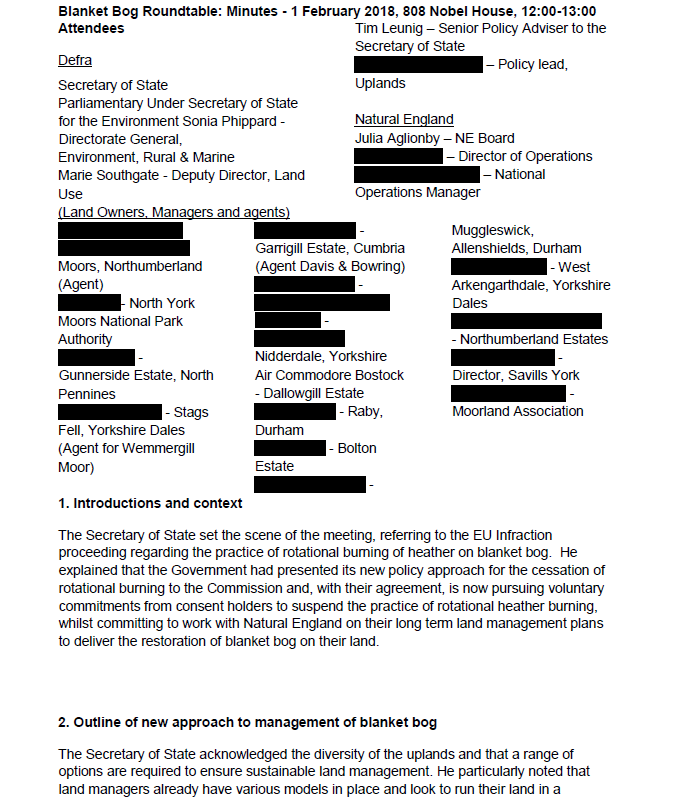
It’s a metaphorical rogues’ gallery of moorland owners and note, for later, that the Moorland Association was represented. It was clearly an important meeting because the Michael Gove himself and Therese Coffey were both present, with an NE Board member and some very senior civil servants. These meetings don’t happen very often. I’m miffed I wasn’t invited – what fun it would have been!
Michael Gove reminded those present, because it is only the taxpayer and the public who are kept in the dark about these things, that Defra was facing infraction proceedings from the EU because, for years, we (it wasn’t me, but it was my country) had been burning a protected habitat, blanket bog, in a damaging way which contravenes the Habitats Directive. Defra wanted those gathered together in the room to go out and spread the word that it was important for all to sign up to voluntary agreements to cease rotational burning of this protected habitat.

Then some wag from the Moorland Association said ‘What about, wink wink, you know, restoration burning if you know what I mean guv [or maybe Gove]?’ and was told that restoration burning was OK and that they could burn the land to blazes up until the time when they signed the voluntary agreement.
There is a strange phrase of ‘suspending the practice of rotational burning on blanket bog would not affect extant consents that have been granted by Natural England‘ which appears contradictory to me unless there is a word missing somewhere.
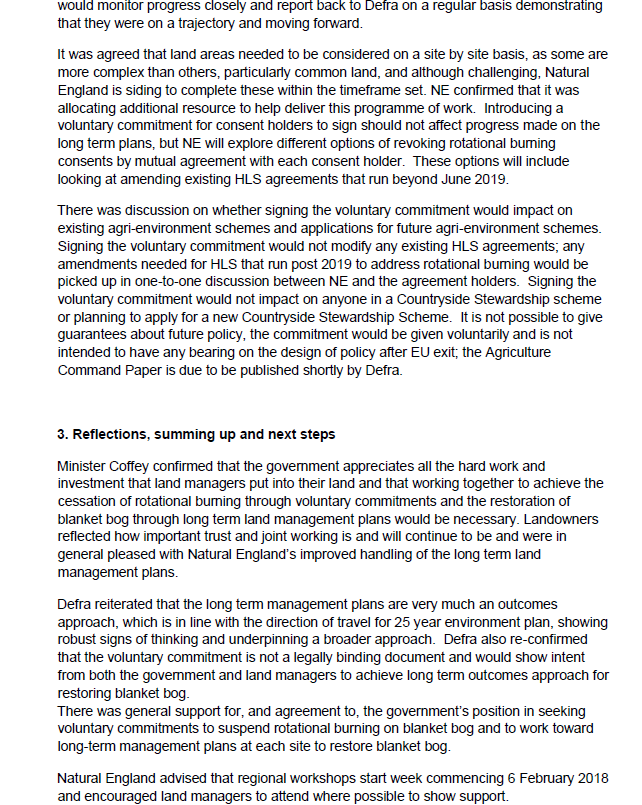
So that was the meeting. It is Defra asking a bunch of mates to cooperate in the short term so that Defra can get the EU off its back.
We know that one of these long term management plans to restore blanket bogs signed soon after this meeting was that for Walshaw Moor which was full of holes as far as controlling burning is concerned and consented, unlawfully, the building of a track across and through the blanket bog that these agreements were supposed to protect. This approach could work – but it looks like a scam to me. It is letting grouse moor managers off the hook because Defra is scared to admit that the existing consents have been allowing damaging burning for years (and we know that NE has allowed another damaging consent to run on for years too) and Defra is too scared or too much in bed with the grouse moor managers, or both, to clamp down on the environmentally damaging behaviours properly.
Remember this has been dragging on for almost six years since RSPB complained to Europe and 18 months before that when the Walshaw Moor court case folded and years before that when NE was trying (as it was then) to get a grip of this damaging practice.
It seems to me that this is a sorry indictment of the state of nature conservation in England these days. We have an industry, grouse shooting, which has been breaking the law (over wildlife protection) for decades and has been allowed to damage a high-priority habitat by the state nature cosnervation agency for years. When the UK was found out then Defra and NE came up with a plan which allows the damaging industry to carry on damaging the protected habitat in a fairly unconstrained way but they get together to construct a pretence of compliance. It is to be hoped that the EU Commission does not swallow this approach as being remotely adequate to achieve favourable conservation status of blanket bogs.
Here is the initial document that landowners have been asked to sign. I expect they have signed in droves – after all it costs them nothing and constrains them very little. What do you think? Do you think that the strongly worded paragraph which starts ‘The Consent holder agrees to suspend rotational burning …‘ is rendered useless by the next short paragraph which says ‘NE accepts and agrees that the suspension of rotational burning agreed to by the Consent Holder is voluntary, not legally binding and does not modify any extant Consent(s).‘. Doublespeak in action (or actually Doublespeak inaction).
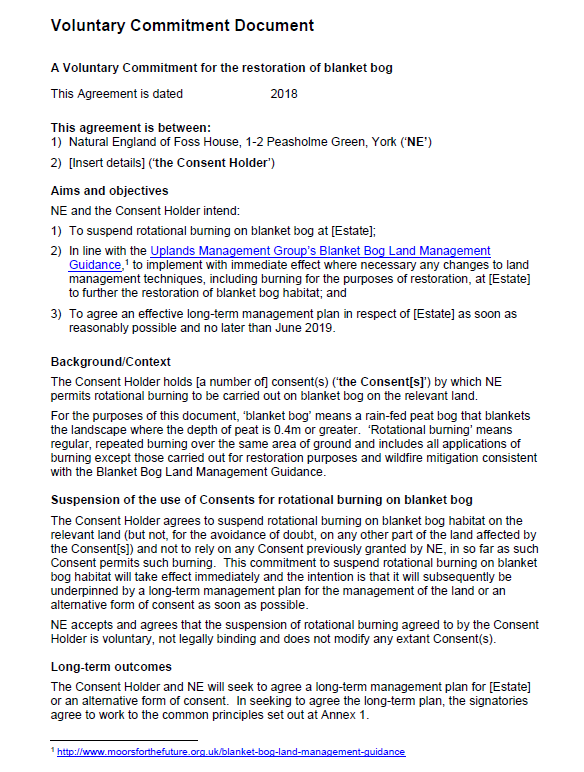
PS Oh yes, and when I asked Defra whether Michael Gove had met various people in an FoI they said no. I’ll bet that Amanda Anderson was ‘the Moorland Association’ at this meeting and so I don’t think Defra told me the truth – but if I’m wrong then they will let me know because I’ve asked them. And it couldn’t possibly have been here, could it, that the reported remark from Michael Gove to grouse moor owners about protecting their vulnerable flank was made? Or could it?
WUTHERING MOORS 75
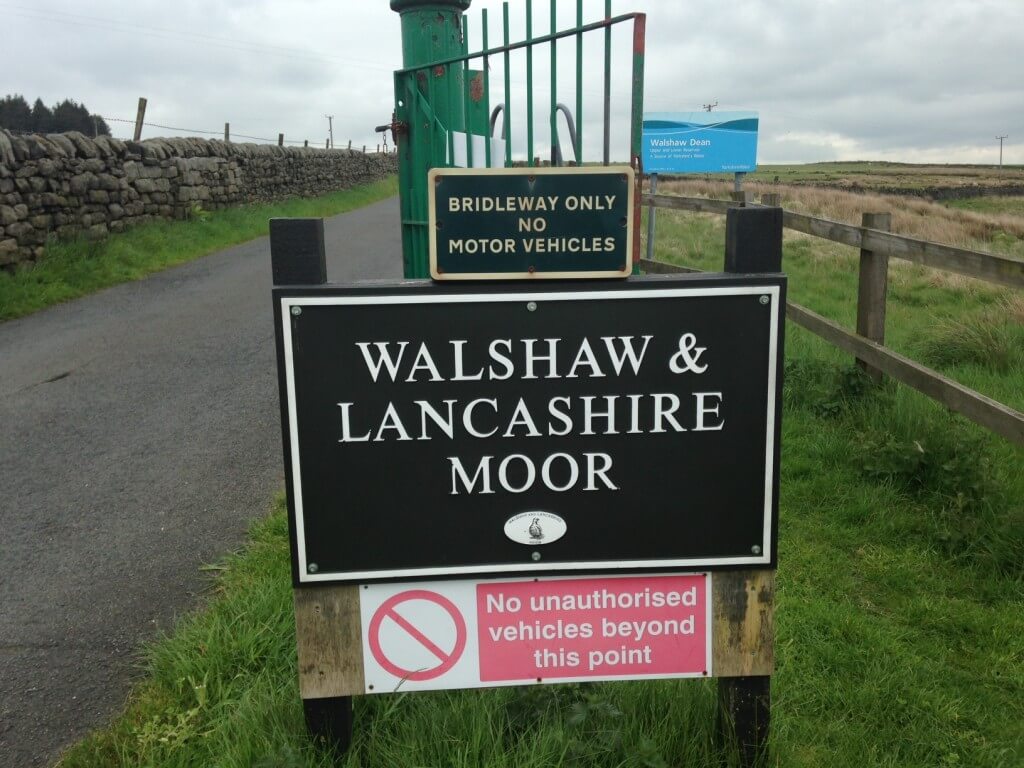
Six years ago today the RSPB made its complaint to the European Commission about burning practices at Walshaw Moor and many other driven grouse moors in the UK (See Wuthering Moors 28, 15 October 2012). The RSPB deserves great respect for this important move (even though it is very quiet about it itself these days).
To cut a very long story short (see Inglorious and posts here entitled Wuthering Moors – there are, with this one, 75 of them now) action started by Natural England, which proved to be abortive, to attempt to regulate damaging burning of blanket bogs led to the RSPB complaining to the European Commission and the Commission threatening infraction proceedings against the UK government and Defra in particular. We are now in the position where Michael Gove and Defra are wriggling and trying to persuade the Commission that everything is OK (see
Wuthering Moors 58, Wuthering Moors 68 and Wuthering Moors 70). But Defra/NE have come up with an inadequate set of measures to regulate habitat damage and are essentially trying to pull the wool over the Commission’s eyes in claiming that they have a grip of moorland burning. Burning of what appears to me to be blanket bog still continues on Walshaw Moor this burning season and it remains to be seen how much will happen elsewhere.
I’ll be blogging later this week on how you can help Defra and NE monitor compliance with what they have promised the European Commission they will achieve.
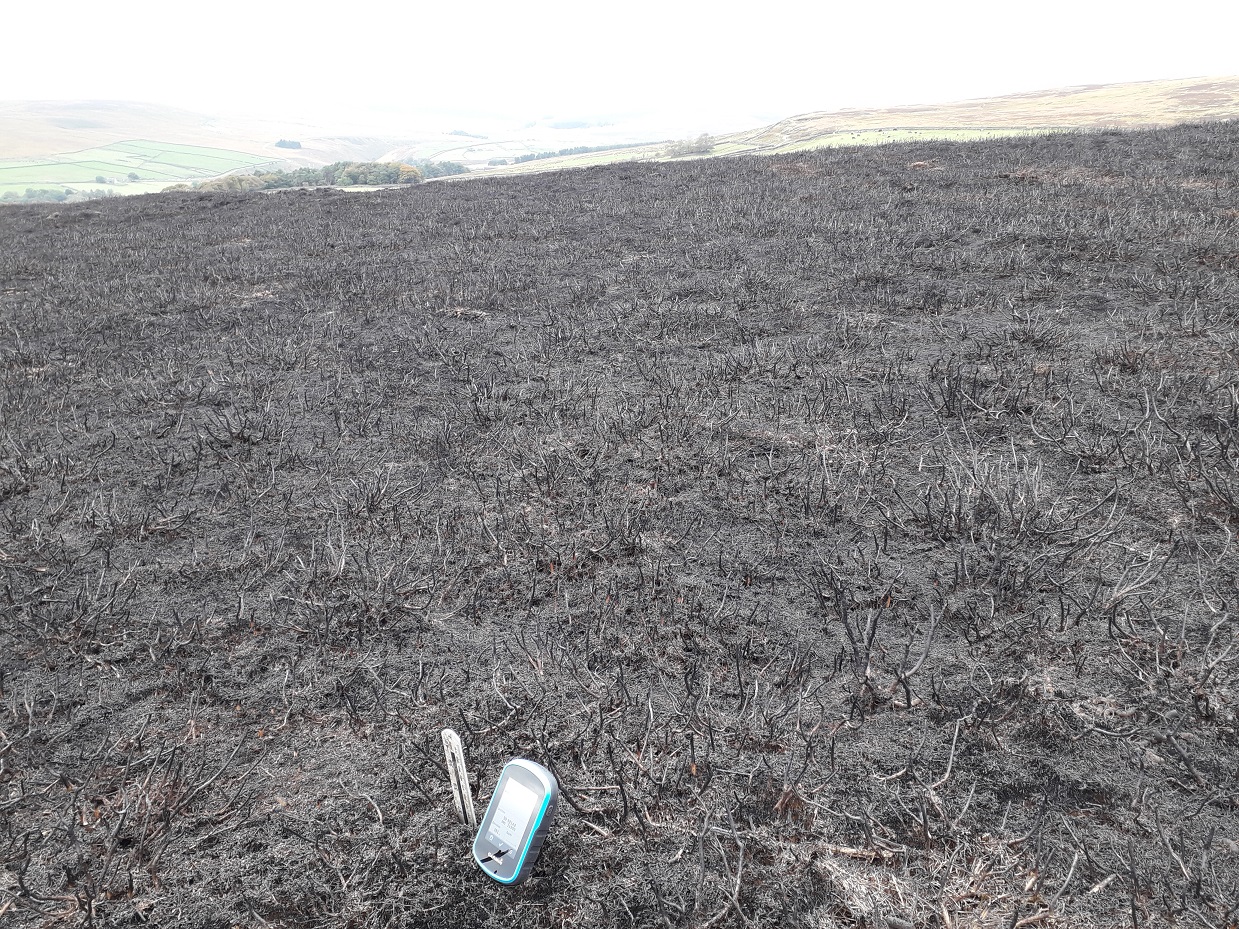
WUTHERING MOORS 69 – a guest blog by Richard Wilson
 Richard Wilson is an independent professional ecologist with just under 20 years experience. When in the field, he specialises in invertebrate and avian ecology, with a smattering of botanical surveying thrown in for good measure. His background as a consultant has led to a keen interest in EU and UK law in the context of nature conservation. He is a full member of the Chartered Institute of Ecology and Environmental Management, a Chartered Environmentalist through the Society for the Environment and a Member of the Royal Entomological Society. He can be followed on Twitter (@ecology_digest)
Richard Wilson is an independent professional ecologist with just under 20 years experience. When in the field, he specialises in invertebrate and avian ecology, with a smattering of botanical surveying thrown in for good measure. His background as a consultant has led to a keen interest in EU and UK law in the context of nature conservation. He is a full member of the Chartered Institute of Ecology and Environmental Management, a Chartered Environmentalist through the Society for the Environment and a Member of the Royal Entomological Society. He can be followed on Twitter (@ecology_digest)
The Walshaw Moor Blogs (1-68): consultation and implications
Back in March 2015, I wrote a guest blog, ‘In Favour of the EU’ as a rebuttal to the alternative guest blog by Richard Wayre on ‘The case against the EU’. In my blog, I argued that remaining in the EU would be a much better course of action for the environment than leaving. 17 million people disagreed with me (and others) and a little over three years after my blog and just under two from the decision to leave, we are within touching distance of the departure gate.
Throughout this time, Mark has been campaigning on an issue related to Walshaw Moor above Hebden Bridge in Yorkshire that is geographically quite close to where I live. This has been brought to the fore through the commencement of legal action, which dramatically resulted in a favourable outcome for nature conservation and which resulted in Natural England being forced to concede defeat before any court appearance. Mark’s 68th blog on this subject, setting out the background prompted me to submit this guest blog as its timing, presumably coincidental, arrived almost concurrently with a consultation issued by Defra on Environmental Principles and Governance after Brexit.
Like many environmental professionals, eyebrows were raised when Michael Gove was appointed Secretary of State for the Environment on the 11th June 2017. Eyebrows were hoisted even higher when he started uttering comments that when listened to again, seemingly suggested he had the environment at heart. As part of these commentaries, Michael made reference for the need to create a robust, advisory body to hold Governments to account. A sort of Nature Conservancy Council-cum-English Nature-cum-Natural England type of organisation with teeth…that bite. Nature conservation NGOs were agog with the direction he was wanting to take the UK post-Brexit.
Part of leaving the EU will inevitably require changes to how we address environmental issues; be they food production, nature conservation (biodiversity), air pollution, water quality and so forth; how to regulate these; how closely UK law should align with EU law on leaving and going forward; and who or what should oversee their implementation. This latter point is the genesis of this short blog, which is the substantive element I discuss below.
As part of the post-Brexit discussions, Defra has mooted the need for an overseeing body or organisation that would hold Government to account. Currently, this is the European Court of Justice (ECJ), which has sufficient dentition to impart a painful nip by way of financial sanctions on any Member State that fails to implement the relevant Directives. And remember that the ECJ is moving towards the doctrine of ‘direct effect’ in the context of implementing Directives. In other words, where a Member State has not fully, or accurately (sufficiently), transposed in to domestic law the requirements of the Directive (i.e. the ‘journey has stopped short’), those provisions not transposed will be deemed to have been.
Last week, Defra published the awaited consultation on this overseeing body and on first and second appraisal, Michael Gove’s earlier warm sentiments towards the environment are revealed in stark contrast to what many commentators were heralding as a welcome change from previous Defra Ministers. In my opinion, the warm words and initial actions, albeit very tokenistic and generally de minimis actions with regards to plastic pollution, have evaporated. The consultation if it proceeds as written, may as well be a death certificate to the environment.
The main document fully supports my justification for remaining in the EU. Two examples of key drivers that underpin environmental due diligence (the precautionary principle and the polluter pays principle), whilst being transferred across to UK domestic law via the EU Withdrawal Bill (paragraph 26 of the Defra consultation document), will seemingly be expunged or significantly altered shortly afterwards. A cynical reaction, but not a surprising one in my view, but allowing the current Government to live up to its promise of transferring EU law across when we leave. On these and other principles, the consultation document expresses the Government’s intention (paragraphs 28 to 42) that they will be amended; and not for the better. Thus, it seems we can expect divergence from the EU acquis to a greater or lesser extent post-Brexit; the details of which we will need to wait until Autumn 2018 when the new Environmental Principles and Governance Bill is published.
What persuaded me to write this Blog in response to Mark’s Walshaw Moor campaign is the consultation’s text starting from paragraph 77 but particularly between paragraphs 95 and paragraphs 108. Paragraphs 77 to 94 sets out the status quo; paragraphs 95 to 108 what the Government’s intentions are; and it is the latter which is particularly pertinent to the Walshaw Case; and indeed any future case of equivalent significance.
As Mark points out, one of the drivers forcing Natural England’s hand is the case before the European Commission where it may take infraction proceedings against the UK Government over burning on a European Protected Site. The penalties if the UK Government are found wanting can be financially significant. Therefore, I would like to draw attention to paragraphs 102 to 104 of the new consultation document. The Government’s intention is to restrict this new body, to issuing a non-binding advisory to the Government. In other words, for almost all examples of where a Government diverges away from environmental law and good governance, Defra are proposing that the ‘teeth’ will be nothing more than a communication, most probably in the form of a letter, asking (not requiring) the Government to think again.
Whilst there is a nod towards more meaningful sanctions (but only a binding letter), judging from the overall tenet of this section of the consultation, the Government are very hesitant in offering even this. There seems to be no comment on any further meaningful sanctions that could be applied.
Therefore, it goes without saying that after we leave the EU, and assuming the new Environmental Governance Bill becomes law in broadly similar terms as presented in this consultation, the scope to challenge poor environmental due diligence is severely and in my opinion, catastrophically diminished. Indeed, it would be pointless to pursue such an action, other than to make a pyrrhic point, as the greatest sanction that would in all likelihood be imposed would be a non-binding letter, asking (pleading?) with the Government to change direction, which would, in my view, fall on deaf ears. In my opinion, this is an indirect consequence of what the Treasury anticipates will befall this country in economic terms once we leave the EU. Regulation comes with a financial cost to business and the public purse, be this paying for environmental due diligence before planning to avoid, mitigate and compensate for habitat and biodiversity impacts; or for example, controlling emissions to reduce or prevent noxious discharges in to the environment. My interpretation is that post-Brexit, the economic pressures on UK businesses are anticipated to be sufficiently severe that relaxation of environmental responsibilities, which businesses are generally accepting, is perceived by the Treasury to require offsetting to compensate for this predicted downturn. This would be a very damaging short-term view that would have up to catastrophic effects on the UK’s, and quite possibly the EU’s environment (air pollution and wildlife don’t respect political boundaries or referendum results).
So returning to Walshaw, were this played out again after we leave the EU, the lack of any organisation that could impose a meaningful sanction removes the threat or motivation to change or alter the mechanism which is being challenged. In this scenario, would Natural England have the will to even engage with the landowner? With no meaningful sanction available, the landowner could, in my opinion, continue with a damaging practice (as viewed through the lens of EU law and science) without risking redress.
Mark’s victory was a victory…but unless the consultation results in a significantly different outcome (or Brexit abandoned), the future looks bleaker; and would not leave the environment in a better place. Indeed, I think we will very likely have crossed the environmental Rubicon.
WUTHERING MOORS 68 – the background to an unlawful decision
 How did NE get into the position of allowing an unlawful Habitats Regulations Assessment to be done? In this blog I will explain what I think has happened. But let me repeat that it is a serious matter when the government nature conservation agency produces an unlawful Habitats Regulations Assessment – Quis custodiet ipsos custodes? Well, it appears that you and I have to do it. And that’s not right.
How did NE get into the position of allowing an unlawful Habitats Regulations Assessment to be done? In this blog I will explain what I think has happened. But let me repeat that it is a serious matter when the government nature conservation agency produces an unlawful Habitats Regulations Assessment – Quis custodiet ipsos custodes? Well, it appears that you and I have to do it. And that’s not right.
Let’s work backwards to uncover the political contex in which an unlawful HRA emerged from Natural England. Much of the following seems to be about a track being built but is actually about burning consents, saving face, money and some quite big politics.
Why was the HRA unlawful?: we believe that it was unlawful on several grounds and NE have conceded on one (but we believe that we would have won at least some of the other grounds in court had we got there). NE conceded on the grounds that they didn’t explain their decision well enough (in layman’s terms).
 Why didn’t NE explain their decision well enough?: maybe that will become clear when NE re-do their HRA, but I believe that they couldn’t explain their decision because it was a wrongly-argued and irrational decision. NE would disagree, but that’s what I think. I think that on the basis that what appears to be an earlier version of the HRA, obtained through a Freedom of Information Act request, states that there would be damage caused by the building of a track across blanket bog, but that this was changed to state that there would not be damage, then it is clear that NE was keen to get past this tricky issue and perhaps somehow, someone in NE cut corners or instructed people to cut corners. Or maybe it was just a massive error. Maybe we’ll find out when a new HRA is produced. It has to be said that NE’s apparent insouciance over consenting a 5km track going through a protected area with habitats of high conservation importance is difficult to take. It’s even more difficult to understand when one realises that it seems as though NE had turned down a very, very similar track a few years ago on this site, on this very route. It wasn’t OK then, but it is OK, apparently, now. How odd! It’s almost as though NE is desperate for the track to be built!
Why didn’t NE explain their decision well enough?: maybe that will become clear when NE re-do their HRA, but I believe that they couldn’t explain their decision because it was a wrongly-argued and irrational decision. NE would disagree, but that’s what I think. I think that on the basis that what appears to be an earlier version of the HRA, obtained through a Freedom of Information Act request, states that there would be damage caused by the building of a track across blanket bog, but that this was changed to state that there would not be damage, then it is clear that NE was keen to get past this tricky issue and perhaps somehow, someone in NE cut corners or instructed people to cut corners. Or maybe it was just a massive error. Maybe we’ll find out when a new HRA is produced. It has to be said that NE’s apparent insouciance over consenting a 5km track going through a protected area with habitats of high conservation importance is difficult to take. It’s even more difficult to understand when one realises that it seems as though NE had turned down a very, very similar track a few years ago on this site, on this very route. It wasn’t OK then, but it is OK, apparently, now. How odd! It’s almost as though NE is desperate for the track to be built!
 Why might NE be keen to consent the building of a damaging track through high priority protected habitats?: well, we can see that someone is very keen on this track because the agreement signed between NE and Walshaw Moor Estate specifically says that nothing in the agreement takes force until the track gets planning permission. That is astounding! Someone is very, very keen on that track being built. I guess it’s the estate, don’t you?
Why might NE be keen to consent the building of a damaging track through high priority protected habitats?: well, we can see that someone is very keen on this track because the agreement signed between NE and Walshaw Moor Estate specifically says that nothing in the agreement takes force until the track gets planning permission. That is astounding! Someone is very, very keen on that track being built. I guess it’s the estate, don’t you?
Why is Walshaw Moor Estate so keen on a track being built? I don’t really know, but it seems that they are. The history of the site shows that they are keen on tracks. Maybe the tracks will make grouse shooting easier? I don’t know.
Surely NE is the regulator and ought to be cracking the whip? Why are they bending over backwards to consent a damaging track across protected habitat?: well, I think I do know the answer to that one. Natural England want to revoke the burning consents that apply to Walshaw Moor and 100+ other grouse moors in the north of England and the means of doing this are by agreements where the estates are persuaded to give up their existing consents – so they have to be jollied along. Handing out unlawful consents for new infrastructure might get the grouse moor owners into a good enough mood to sign an agreement on burning.
Why can’t the burning consents be revoked anyway, without agreement?: they can. But the existing consents run for a couple of decades or so and the grouse moor owners don’t want to give up their rights to burn even though the burning rights they have damage protected habitats for wildlife, because they care most about Red Grouse numbers and not wildlife on the moors. So what is the  likelihood that a bunch of grouse moor owners would take legal action against NE if NE withdrew existing burning consents? Very high! I think NE and Defra should man-up and withdraw those consents anyway. But if they did then the grouse moor managers would say that they had invested their energies and money into building up their businesses (the business of shooting wild Red Grouse for fun and profit) on the basis of consents that were given to them by NE and government and they ought to be compensated for losses. They’d argue that the losses would be enormous. NE and Defra have run away from this fight – I’d love to know why but I can only speculate.
likelihood that a bunch of grouse moor owners would take legal action against NE if NE withdrew existing burning consents? Very high! I think NE and Defra should man-up and withdraw those consents anyway. But if they did then the grouse moor managers would say that they had invested their energies and money into building up their businesses (the business of shooting wild Red Grouse for fun and profit) on the basis of consents that were given to them by NE and government and they ought to be compensated for losses. They’d argue that the losses would be enormous. NE and Defra have run away from this fight – I’d love to know why but I can only speculate.
My speculation is that it’s a mixture of things: lack of any real interest in nature conservation values in the higher echelons of NE and its board (not a complete lack of interest, but an overall lack of interest (the good guys are outnumbered by the bad guys)), fear of losing and it costing a lot of money, fear of those influential grouse moor owners cutting up rough in lots of other ways, lack of worry that the wildlife NGOs will be as tough as the grouse moor owners and in some cases, the grouse moor owners are the mates of the party of government so it would attract political attention to annoy these people (see pages 149-57 of Inglorious for examples of correspondence when NE last tried to get tough with these people).
So why is NE trying to revoke these burning consents at all? Why not quietly forget about them?: we know the answer to that! It’s because the European Commission is taking infraction proceedings, or might do, against the UK for damaging EU priority habitats by allowing grouse moor owners to danmage them by burning the blanket bogs.
 Why is the European Commission doing that?: they are doing that because the UK signed up to the Habitats and Birds Directives and it’s one of the jobs of the Commission to stop back-sliding on the deal by Member States. Yes, all Member States try to cheat a bit, some of them a lot, but the Commission can whip them into shape by negotiating and then imposing fines. That is what is happening here. The Commission has told Defra to end the damaging practices or get hefty fines. Little of this in the public domain, but that is what is happening.
Why is the European Commission doing that?: they are doing that because the UK signed up to the Habitats and Birds Directives and it’s one of the jobs of the Commission to stop back-sliding on the deal by Member States. Yes, all Member States try to cheat a bit, some of them a lot, but the Commission can whip them into shape by negotiating and then imposing fines. That is what is happening here. The Commission has told Defra to end the damaging practices or get hefty fines. Little of this in the public domain, but that is what is happening.
Why is the European Commission all fired up about this?: because it’s their job, and also because they were tipped off about the sad state of affairs by the RSPB making a complaint in 2012 and the Hebden Bridge Ban the Burn campaigners taking a complaint of a similar nature in 2012 or very early in 2013. These complaints were focussed on Walshaw Moor but took a wider view too. Most of the traffic between Defra and the EC is secret but I did flush some of it outback in Wuthering moors 34 in September 2013.
So have I got this right? Defra either has to pay big fines to the European Commission for damaging blanket bogs or big compensation to the grouse moor owners so that they don’t damage blanket bogs?: I think so – it seems crazy doesn’t it? Unless they can get the grouse moor owners voluntarily to agree to stop burning blanket bogs, of course.
But why would the grouse moor owners and managers agree voluntarily to stop doing something they really want to do?: good question! Why would they? Either it means that they aren’t so fussed about blanket bog burning as they pretend to be – I think there will be an element of that in it. And/or, they think they can wring other concessions out of NE in the process – maybe like consents for tracks? And/or the agreements aren’t quite as tough as they are made out to be.
Tell me about the last one of those – pretend toughness: pretend toughness is a good term for it. The Walshaw Moor agreement is a good example of pretend toughness. It allows something called ‘restoration burning’of blanket bogs at the estate’s discretion which could easily amount to ‘carry on as you have been chaps’ and it allows burning of heather for Heather Beetle management too (even though there is scant evidence that burning is helpful in this regard apart from in old wives’ tales). In other words the burning consents are revoked, by mutual agreement, but the ability to burn remains through massive loopholes. See Wuthering moors 58 of 13 February this year.
So you believe that Defra and NE are not clamping down on burning but need the cooperation of moorland owners to roll out this charade and it’s all to con the European Commission into believing, or at least accepting, that the UK has got its act together and is no longer allowing priority habitats to be damaged by burning?: yes, that’s what I think is happening.
So when I asked why did NE produce an unlawful HRA particularly for the construction of a track the short answer is: NE needed to consent the track to get the estate to sign the plan that makes it look as though burning is being controlled and to get the European Commission off the UK’s back?: yes, that’s what I think.

But won’t something like this have to happen on lots of estates across the country for it to work?: yes, so it’s good that we have highlighted this one! Defra may be hoping that the European Commission will start to lose interest when it thinks that it has made some progress. Or maybe Mr Gove is simply promising all that when we leave the EU this or another government will dump this stuff and gives moorland managers carte blanche.
That wouldn’t happen would it?: I am sure that the Commission has been tipped off and I bet they will read this blog. But leaving the EU, and watering down environmental protection – that’s what some strong Brexiteers want, and that’s what we might well get. I didn’t vote for it.
So what should we do?: I’ll come back to that soon. But just take a while, as I am, to celebrate the stick we stuck in the spokes of NE’s wheels yesterday. It was us – we derailed this part of the plan. There are some bruised people out there. Gather ye sticks! More bruising needed!
WUTHERING MOORS 67 – a significant victory!
Yesterday afternoon our lawyers at Leigh Day received a delayed response from Natural England on our Pre-action Protocol letter about Walshaw Moor. It contained the following important phrases:
‘Natural England accepts that in relation to ground (2), the HRA could have been clearer in certain respects. In particular, Natural England accepts that it is not clear how the conclusion of no adverse effect on integrity at page 65 of the HRA is reached, notwithstanding the text on pages 51-56 that notes among other things “a significant loss when considering the total resource across the site and the importance of this habitat in the national and international context”.‘
‘While this is not a point taken by Dr Avery, Natural England also acknowledges that the approach adopted in Part C of the HRA (screening) is not in accordance with the latest judgment on this topic from the Court of Justice of the European Union (CJEU), Case C-323/17 People Over Wind‘.
‘For those reasons, Natural England agrees to review the HRA more generally and if appropriate in light of that review to withdraw its agreement to the Plan and/or to reflect any different conclusion in any consultation response.‘.
I didn’t see this until mid-evening yesterday and I’ve spent some of today getting my head around this. But, we won!
NE have conceded on one ground – we believe they would have lost in court on more than one ground.
It is unusual for a government agency or department to concede at this stage of any case – the letters before action are often a bit of ritual jousting rather than the full-on conflict. But in this case, our lawyers had done such a good job, and let’s face it, NE had done such a bad job, that it would not have been in the public interest for NE to fight a case they would most likely lose (that’s my interpretation, anyway). So, we won!
NE have to think again on the Habitats Regulations Assessment that they did for Walshaw Moor and they will know that they must do a better job in future as we are watching them. NE will also have to inform Calderdale and Pendle Councils that the NE HRA is under review and not to be relied upon. And NE will need to be scrupulously careful in future agreements with other landowners. The consequences are significant.
Remember that NE has a regulatory function and we have shown that the regulator, whose job it is to ensure that wildlife laws are respected, itself produced an unlawful regulatory assessment. That is no small matter.
Our letter of response to NE is copied below. And I am perfectly content for NE to publish the whole of their letter to which we replied if they so wish.
I will write more on this tomorrow, despite travelling at the moment (!), but I cannot move on without thanking some people. First our legal team at Leigh Day, particularly Tessa, Carol and Lewis, who are great fun to work with and great professionals too. Also, the barristers, who can remain anonymous since we are now not going to have them arguing our case in court. Not for a while anyway. But also to all of you who supported the crowdfunder – we’ve had a quick return on our investment! Without public moral and financial support it would be impossible for me to take such a case forward. And also there are a few other people who have helped with advice and support but they had better remain nameless to protect their own interests.
Sent by email to NE late this afternoon:
Dear Sirs
Walshaw Moor Estate Pre-action Protocol Letter
We write in reply to your Pre-action Protocol response dated 9 May 2018.
Grounds
- We note Natural England’s concession that the HRA for the Walshaw Moor Catchment Restoration Plan is unlawful for failing to provide adequate reasons for the conclusions within the Assessment (our Ground 2). However, we do not accept your comments on our other grounds (Grounds 1 & 3-5) and we reserve the right to challenge any fresh decision on those and/or other grounds.
Review
- We welcome Natural England’s agreement to review the HRA. As part of this process, and to ensure Natural England has a complete understanding of the extent of the blanket bog and be able properly to assess potential adverse effects, our client believes that the peat depth along the length of the proposed track should now be measured by independent competent experts.
Consultation
- We are grateful for your undertaking to review the HRA and to ‘consider inviting further comments on the nature of the proposed track and its impacts’ from our client. We remind you that public participation is an important aspect of the screening and HRA process and, in light of this; we consider it would be to the parties’ mutual interest that proper consultation on this important matter is not merely ‘considered’ by Natural England, but guaranteed.
- Our client would be pleased to work with Natural England to ensure the HRA is conducted lawfully and we should therefore be grateful if you would provide some detail on the nature and extent of the proposed consultation, including your proposed timescale and the steps involved. Our client believes it would be beneficial for Natural England also to consult with the RSPB who we believe have an interest in this case and useful expertise in both moorland ecology and the appropriate implementation of the Habitats Regulations.
- Our client would like to make clear that these plans, of which there will be numerous over the next two years, are an opportunity for Natural England to improve and ensure protection of designated sites, and not to undermine that protection. An example of this would be for Natural England to seek to remove consent for use of lead shot on all blanket bog SSSIs, as was done in the West Pennines Moor SSSI citation.
- In anticipation of proper consultation, we should be grateful if you would explain to us how the management plan addresses the requirements of the EU infraction proceedings which are in respect of reducing the impacts of burning on protected blanket bogs.
- Our client also proposes that Natural England publish on its website in a prominent and accessible manner (in the interests of openness and proper public participation) all such management agreements which involve revocation of burning consents as they amount, potentially, to a significant change in practice affecting conservation policy across many protected areas of high conservation value in England, and are a matter of considerable public interest.
Costs
- In light of your concession that your HRA for the Catchment Restoration Plan is unlawful on the basis of our Ground 2, we invite you to agree to pay our client’s reasonable costs incurred engaging with you in (extended) pre-action correspondence which has enabled your client to act lawfully, without which that would not have happened.
Conclusion
- We should be grateful if you would confirm safe receipt of this letter and acknowledge that you will address the points raised above.
Yours faithfully
Leigh Day
WUTHERING MOORS 66 – Natural England you have lost the trust of the public
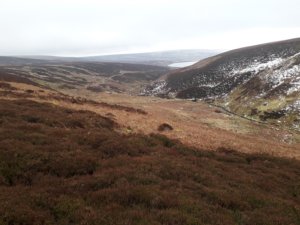 Nobody really trusts politicians these days (which personally I think is sad because there are some good ones out there) but until recently we have trusted government agencies. In nature conservation, in the olden days, some of the greatest nature conservationists of their time, of any time, worked in and led the statutory agencies – and yes, I have Derek Ratcliffe in mind amongst many others.
Nobody really trusts politicians these days (which personally I think is sad because there are some good ones out there) but until recently we have trusted government agencies. In nature conservation, in the olden days, some of the greatest nature conservationists of their time, of any time, worked in and led the statutory agencies – and yes, I have Derek Ratcliffe in mind amongst many others.
After reorganisations and cuts our statutory agencies are shadows of their former selves – and yet the job we need them to do is just as great and just as difficult as ever.
There are many good staff in Natural England but it is a failing organisation – failing to do its job for nature, failing the public and therefore failing to retain our trust.
Our crowdfunder is to take legal action against Natural England – to make them do their job properly! I’m sad that it has come to this. It would have been hard to imagine a decade ago and it’s the consequence of political neutering of a once laudable organisation (if you consider NE, EN, NCC and NC as being one evolving body).
Just look at some of the comments that supporters of this legal challenge have attached to their donations:
- Keith £50 – Natural England are a corrupt body
- Chris £10 – We’re standing up to the nature trashers because are NGOs and Statuatory Bodies don’t have the stomach for the fight
- David £10 – Natural England has been weakened so drastically that it offers very little protection & needs to be challenged
- Brian £35 – Good luck with this Mark, Natural England have lost all credibility, in backing this proposed track with downright dodgy data!
- Chris £500 – I’m pleased to give but confounded by the fact that I’ve already paid these miscreants through my taxes – they are so compromised
- Nigel £25 – Natural England seem to be less fit for purpose than the Home Office, if that’s possible.
- Tracey £10 – Thank you for taking this ridiculous department to task.
- Mike £10 – The four countries’ statutory advisers are not fit for purpose. They need a very fundamental reform, so that they stand up for biodiversity, including objecting to damaging development proposals
- Rosemary £100 – It is outrageous that Natural England can allow a landowner to damage his land
And that is just a selection of some of the most recent bolshy comments.
Win or lose this case – and I am confident that we can win – under this government and under its recent and present leadership, Natural England has lost the trust of the public. We do not think that NE is working for wildlife and we do not think that it is working for the taxpayer.
Please help draw a line in the sand – or actually in the peat – and make NE do its job properly. Please add your support to this crowdfunder to mount a legal challenge which, if successful, will make NE do its job properly. Thank you.
WUTHERING MOORS 66 – amazing support thank you!
WUTHERING MOORS 65
 The crowdfunder to support legal action against Natural England‘s failure to protect Walshaw Moor launched yesterday at 1pm – by 10pm it had already reached the first target of £5000. I’m so relieved and so grateful. This means that we can move forward with confidence and that I am not left with a big debt!
The crowdfunder to support legal action against Natural England‘s failure to protect Walshaw Moor launched yesterday at 1pm – by 10pm it had already reached the first target of £5000. I’m so relieved and so grateful. This means that we can move forward with confidence and that I am not left with a big debt!
What I do have is a big debt of gratitude to you for setting off on this new journey with me – thank you very much.
This case is about two things. First, and most importantly to me, it’s about protecting our best wildlife sites. Walshaw Moor has just about every nature conservation designation and notification that a place can have – and yet it is threatened by damaging burning and by a proposed 5km track through its most sensitive habitats. This is wrong – it’s morally wrong and our view is that it is also legally wrong.
Second, it’s about making Natural England do its job properly. NE will be making over 100 agreements of a similar form with other upland landowners over this year and next – we need to make sure that they are of a much higher standard than this one. We need to draw a line in the sand – or in fact a line in the peat. If Michael Gove, Therese Coffey, Andrew Sells, James Cross and the NE Board can’t get NE to do their job properly then we taxpayers and citizens must step in. They work for us, and they should be working for nature.
If you agree then please donate here – there’s a long way to go to meet our overall target so that the lawyers can get paid, court costs can be met and in the worst case scenario, we can pay costs to the other side.
See yesterday’s blog with more information about the case and about the history of Walshaw Moor.
WUTHERING MOORS 64
WUTHERING MOORS 63
WUTHERING MOORS 62
WUTHERING MOORS 61
WUTHERING MOORS 60
WUTHERING MOORS 59
WUTHERING MOORS 58
WUTHERING MOORS 57
WUTHERING MOORS 56
WUTHERING MOORS 55
WUTHERING MOORS 54
WUTHERING MOORS 53
WUTHERING MOORS 52
WUTHERING MOORS 51
WUTHERING MOORS 50
WUTHERING MOORS 49
WUTHERING MOORS 48
WUTHERING MOORS 47
WUTHERING MOORS 46
WUTHERING MOORS 45
WUTHERING MOORS 44
WUTHERING MOORS 43
WUTHERING MOORS 42
WUTHERING MOORS 41
WUTHERING MOORS 40
WUTHERING MOORS 39